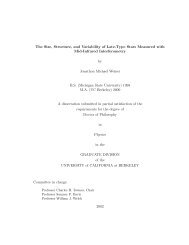Roger Griffith Physics 137B hw. # 9 Proffessor Clarke Problem # 1 ...
Roger Griffith Physics 137B hw. # 9 Proffessor Clarke Problem # 1 ...
Roger Griffith Physics 137B hw. # 9 Proffessor Clarke Problem # 1 ...
You also want an ePaper? Increase the reach of your titles
YUMPU automatically turns print PDFs into web optimized ePapers that Google loves.
we will need to use the following identity for the next part<br />
we find the coefficient to be<br />
2isin(ω 31 t/2) = e iω 31t/2 − e −iω 31t/2<br />
so we get<br />
a 3 (t) = − i <br />
Z t<br />
H ′<br />
0<br />
= − 2A<br />
a eiω 31t/2<br />
The rate of transition is given by<br />
31 eiω 31t ′ dt ′ = − 2Ai Z t<br />
e iω 31t ′ dt ′ = − 2A [ e<br />
iω 31 t ]<br />
− 1<br />
t<br />
a 0<br />
a ω 31 t<br />
[<br />
]<br />
e iω31t/2 − e −iω 31t/2<br />
t = − 2A [ isin(ω31 t/2)<br />
ω 31 t<br />
a eiωt/2 ω 31 t/2<br />
a 3 (t) = − 2A<br />
a eiω 31t/2<br />
[ isin(ω31 t/2)<br />
ω 31 t/2<br />
]<br />
t<br />
]<br />
t<br />
|a 3 (t)| 2<br />
t<br />
=<br />
( ) 2A 2 ( )<br />
a t sin(ω31 t/2) 2<br />
since ω 31 t ≪ 1<br />
ω 31 t/2<br />
sin(ω 31 t/2)<br />
ω 31 t/2<br />
⇒ 1<br />
we get<br />
|a 3 (t)| 2<br />
t<br />
= 4A2<br />
2 a 2 t<br />
<strong>Problem</strong> # 2<br />
A hydrogen atom in its ground state is placed between the parallel plates of a capacitor. The z-axis<br />
of the atom in perpendicular to the capacitor plates. At time t = 0, a uniform electric field⃗ε =⃗ε 0 e −t/τ is<br />
applied to the atom. The perturbing Hamiltonian is thus<br />
H ′ = −e⃗r ·⃗ε 0 e −t/τ = −ezε 0 e −t/τ<br />
and since z is given by z = r cos(θ)<br />
we find the Hamiltonian to be<br />
H ′ = −er cos(θ)ε 0 e −t/τ<br />
and the three hydrogen wave functions needed for this problem are given as<br />
ψ 100 = √<br />
1 e −r/a 0<br />
ψ 200 = 1 (<br />
1<br />
√ 1 − r )<br />
e −r/2a 0<br />
ψ 210 = 1<br />
πa 3 2πa0 2a 0 2a 0<br />
0<br />
√<br />
2π<br />
1<br />
4a 5/2<br />
0<br />
cos(θ)e −r/2a 0<br />
(a) Show that the electron has zero probability of being excited into the 2s state Ψ nlm = Ψ 200<br />
what we are looking for is |a 200 (t)| 2 so we must use the formula<br />
a 200 (t) = − i <br />
Z t<br />
0<br />
H ′<br />
k j eiω k jt ′ dt ′<br />
2












![Problem #1 [Structure Formation I: Radiation Era]](https://img.yumpu.com/37147371/1/190x245/problem-1-structure-formation-i-radiation-era.jpg?quality=85)



